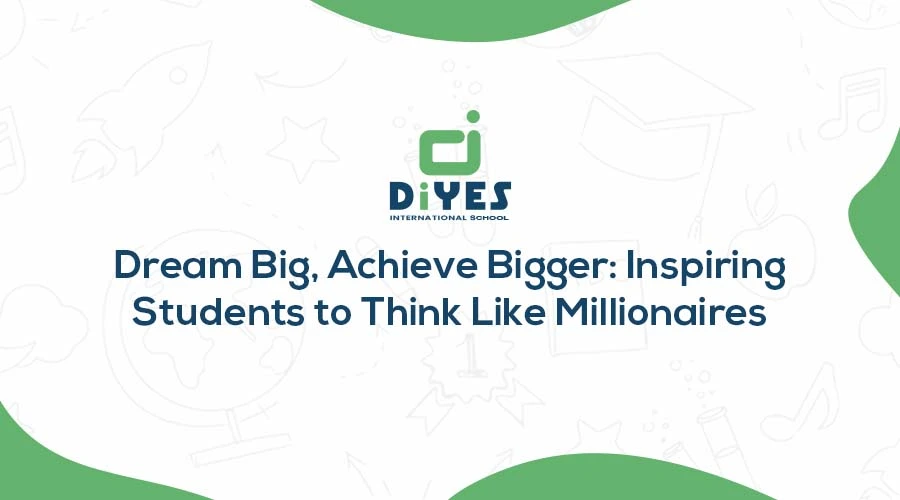In today’s rapidly changing world, success is often measured not just by academic achievements, but also by one’s ability to think creatively, innovate, and pursue ambitious goals. Secrets to developing the millionaire mindset in students lie in nurturing an environment where young minds can flourish beyond traditional boundaries.

This blog delves into the concept of cultivating an entrepreneurial mindset in students, encouraging them to think like millionaires by setting audacious goals, accepting failure as a stepping stone to success, and taking calculated risks to pursue their passions. Through real-life examples, practical tips, and motivational insights, students will learn how to build millionaire mindset in kids by unlocking their full potential, overcoming obstacles, and charting their own path to success.
Setting Audacious Goals
Setting audacious goals involves envisioning ambitious aspirations that go beyond conventional expectations, driving students to push their boundaries and strive for greatness.
- Visualizing Success: Encouraging students to vividly visualize their goals and aspirations ignites their passion and determination to achieve them. Visualizing success allows students to create mental images of their desired outcomes, reinforcing their commitment and focus. Through visualization, students can develop a clear sense of purpose and motivation, fuelling their efforts to pursue audacious goals relentlessly.
- Breaking Down Barriers: Teaching students to break down their audacious goals into smaller, manageable steps empowers them to navigate challenges systematically and stay focused on their objectives. By breaking down barriers, students can overcome feelings of overwhelm and take practical actions towards their aspirations. This process also helps students identify specific action steps, deadlines, and milestones, making their goals more attainable and less daunting.
- Seeking Mentorship: Connecting students with mentors who have achieved similar goals provides invaluable guidance, support, and inspiration on their journey to success. Mentors offer insights, share experiences, and provide encouragement, helping students navigate obstacles and stay motivated. Mentorship relationships allow students to learn from the experiences and mistakes of others, accelerating their progress and helping them avoid common pitfalls along the way.
- Cultivating Growth Mindset: Cultivating a growth mindset in students helps them view setbacks and failures as opportunities for learning and growth. Welcoming a growth mindset enables students to overcome self-doubt, persevere through challenges, and continually strive for improvement. By adopting a growth mindset, students develop resilience, tenacity, and a belief in their ability to overcome obstacles and achieve their audacious goals.
- Celebrating Milestones: Celebrating small victories along the way reinforces students’ confidence, motivation, and sense of accomplishment. Recognizing and celebrating milestones provides positive reinforcement, boosts morale, and encourages students to persist in their pursuit of audacious goals. Celebrating milestones also allows students to reflect on their progress, acknowledge their hard work, and stay committed to their long-term aspirations.
Setting audacious goals empowers students to unlock their full potential, overcome obstacles, and achieve extraordinary success. By visualizing success, breaking down barriers, seeking mentorship, accepting a growth mindset, and celebrating milestones, students can cultivate the mindset of a millionaire and turn their wildest dreams into reality.
Accepting Failure as a Stepping Stone to Success
Accepting failure as a stepping stone to success involves reframing setbacks as valuable learning experiences that propel students forward on their journey to achievement.
- Changing Perspectives: Encouraging students to view failure not as a final outcome, but as a temporary setback that offers valuable lessons and insights. By changing perspectives, students can cultivate resilience and perseverance in the face of adversity. Viewing failure as a natural part of the learning process empowers students to approach challenges with optimism and resilience, knowing that setbacks are opportunities for growth and improvement.
- Learning from Mistakes: Helping students analyze their failures objectively, identify areas for improvement, and develop strategies to overcome similar challenges in the future.

By learning from mistakes, students gain valuable insights and skills that contribute to their personal growth and development. Encouraging students to reflect on their failures and identify specific lessons learned helps them extract maximum value from their experiences and apply those insights to future endeavours.
- Building Resilience: Teaching students to bounce back from failure with resilience, perseverance, and determination. Building resilience empowers students to face challenges with courage and optimism, knowing that setbacks are temporary obstacles on the path to success. By cultivating resilience, students develop the emotional strength and fortitude to persevere through adversity, overcome obstacles, and achieve their goals.
- Nurturing Adaptability: Encouraging students to adapt and pivot in the face of failure, exploring alternative strategies and approaches to achieve success. Nurturing adaptability equips students with the flexibility and resourcefulness to navigate changing circumstances and overcome obstacles. By accepting change and innovation, students can turn setbacks into opportunities for growth and innovation, paving the way for future success.
- Cultivating Grit: Cultivating grit and determination in students, instilling in them the belief that setbacks are opportunities for growth and learning. Cultivating grit empowers students to persevere through adversity, stay focused on their goals, and ultimately achieve success. By nurturing a sense of resilience and determination, educators can help students develop the perseverance and tenacity to overcome challenges and achieve their dreams.
Accepting failure as a stepping stone to success empowers students to develop resilience, perseverance, and adaptability in the face of adversity. By changing perspectives, learning from mistakes, building resilience, nurturing adaptability, and cultivating grit, students can harness the power of failure to fuel their growth and achievement.
Taking Calculated Risks to Pursue Passions
Taking calculated risks involves stepping outside one’s comfort zone to pursue opportunities that have the potential for growth and success, challenging students to explore new possibilities and seize opportunities for advancement.
- Identifying Opportunities: Encouraging students to identify opportunities aligned with their passions, interests, and strengths. By identifying opportunities, students can focus their efforts on endeavours that resonate with their values and aspirations. Encouraging students to explore a variety of interests and passions helps them discover their unique talents and strengths, empowering them to pursue opportunities that align with their personal and professional goals.
- Assessing Risks and Rewards: Teaching students to assess the potential risks and rewards of pursuing different opportunities, considering factors such as feasibility, potential outcomes, and personal values. By assessing risks and rewards, students can make informed decisions that align with their goals and aspirations. Encouraging students to weigh the potential benefits and drawbacks of different opportunities helps them develop critical thinking and decision-making skills, empowering them to make strategic choices that support their long-term success.
- Developing Decision-Making Skills: Helping students develop critical thinking and decision-making skills to evaluate risks objectively, weigh alternatives, and make informed choices. Developing decision-making skills empowers students to navigate uncertainty and make strategic decisions that support their long-term goals. By providing opportunities for students to practice making decisions in a supportive environment, educators can help them develop confidence and competence in their ability to assess risks and make informed choices.
- Building Confidence: Providing opportunities for students to take calculated risks in a supportive environment, where they can experiment, learn from experience, and build confidence in their abilities.

Building confidence enables students to trust in their judgement, take initiative, and pursue their passions with conviction. Encouraging students to step outside their comfort zones and take calculated risks helps them develop resilience, self-assurance, and a belief in their ability to overcome challenges and achieve their goals.
- Encouraging Resilience: Encouraging students to cultivate resilience in the face of uncertainty and setbacks, recognizing that taking risks involves the possibility of failure but also the potential for growth and success. Developing resilience equips students with the courage and fortitude to persevere through challenges and continue pursuing their passions. By nurturing a sense of resilience and determination, educators can help students navigate obstacles, overcome setbacks, and emerge stronger and more resilient than before.
Taking calculated risks to pursue passions empowers students to seize opportunities for growth and achievement. By identifying opportunities, assessing risks and rewards, developing decision-making skills, building confidence, and embracing resilience, students can step outside their comfort zones and pursue their dreams with courage and determination.
Cultivating Entrepreneurial Mindset
Cultivating an entrepreneurial mindset involves nurturing students’ creativity, innovation, and problem-solving skills, empowering them to identify opportunities, take initiative, and create value in various aspects of their lives.
- Encouraging Creative Thinking: Encouraging students to think outside the box, generate innovative ideas, and explore creative solutions to real-world problems. By nurturing creative thinking, educators can empower students to approach challenges with curiosity, imagination, and ingenuity. Providing opportunities for brainstorming, ideation, and creative experimentation helps students develop the mindset and skills necessary to innovate and create value in their personal and professional endeavours.
- Promoting Risk-Taking: Promoting risk-taking and experimentation in a supportive environment where students feel safe to explore new ideas, take initiative, and learn from failure. By promoting risk-taking, educators can help students overcome fear of failure, embrace uncertainty, and develop resilience in the face of setbacks. Encouraging students to take calculated risks nurtures a culture of innovation and entrepreneurship, empowering them to pursue opportunities with confidence and conviction.
- Instilling Problem-Solving Skills: Instilling problem-solving skills in students, equipping them with the ability to identify challenges, analyze problems, and develop effective solutions. By instilling problem-solving skills, educators can empower students to tackle complex problems and overcome obstacles in their personal and professional lives. Providing opportunities for hands-on, experiential learning enables students to apply critical thinking, creativity, and resourcefulness to solve real-world problems, preparing them to navigate the challenges of an ever-changing world.
- Nurturing Resilience: Nurturing resilience in students, teaching them to bounce back from failure, adapt to change, and persevere in the face of adversity. By nurturing resilience, educators can empower students to embrace challenges as opportunities for growth and learning. Encouraging students to view setbacks as temporary obstacles on the path to success helps them develop the resilience and determination to overcome obstacles and achieve their goals. Providing support, encouragement, and guidance during times of adversity enables students to build confidence in their ability to overcome challenges and succeed in their entrepreneurial endeavours.
- Developing Entrepreneurial Skills: Developing entrepreneurial skills in students, including communication, leadership, teamwork, and financial literacy, to prepare them for success in the business world. By developing entrepreneurial skills, educators can equip students with the competencies and confidence to pursue entrepreneurial ventures and create value in their communities. Providing opportunities for students to develop and practice these skills through hands-on projects, experiential learning, and mentorship programs helps them build a strong foundation for future success as entrepreneurs and innovators.
Conclusion
An entrepreneurial mindset in students is crucial for success in an ever-changing world. By encouraging creativity, promoting risk-taking, instilling problem-solving skills, resilience, and developing entrepreneurial skills, educators equip students with essential tools for thriving. This mindset prepares students for the business world and empowers them to navigate life’s challenges while making a positive impact on society.
In the world of education, nurturing an entrepreneurial mindset among students is paramount for preparing them to excel in a rapidly evolving world. By setting audacious goals, accepting failure as a stepping stone to success, taking calculated risks to pursue passions, and cultivating entrepreneurial skills, educators empower students to unlock their full potential and make meaningful contributions to society. Through these strategies, students develop the resilience, creativity, and determination necessary to navigate challenges, overcome obstacles, and achieve extraordinary success.
Encouraging students to set audacious goals ignites their passion and determination to pursue greatness, while also teaching them to break down barriers, seek mentorship, embrace a growth mindset, and celebrate milestones along the way. Similarly, embracing failure as a natural part of the learning process helps students develop resilience, learn from their mistakes, and persevere through adversity. By reframing setbacks as opportunities for growth and learning, students develop the courage and resilience to overcome obstacles and achieve their goals.
Furthermore, taking calculated risks to pursue passions enables students to explore new opportunities, develop decision-making skills, build confidence, and adopt resilience in the face of uncertainty. By encouraging students to identify opportunities aligned with their interests and strengths, assess risks and rewards, and step outside their comfort zones, educators empower them to pursue their dreams with courage and determination. Ultimately, by cultivating an entrepreneurial mindset, educators equip students with the skills, mindset, and confidence to excel in an ever-changing world, making a positive impact on society and shaping the future for generations to come.
At DiYES International School, we believe in nurturing an environment that encourages students to dream big and pursue their passions with confidence and determination. Through our innovative educational approach, we empower students to develop an entrepreneurial mindset, set audacious goals, accept failure as a learning opportunity, and take calculated risks to pursue their dreams. With personalized support, mentorship, and a dynamic learning environment, we inspire students to think like millionaires and make their aspirations a reality.
For more information about DiYES International School and our approach to nurturing students’ millionaire mindset, visit our website at www.diyesinternational.edu.in . You can also reach us by phone at +91 8547609000.


